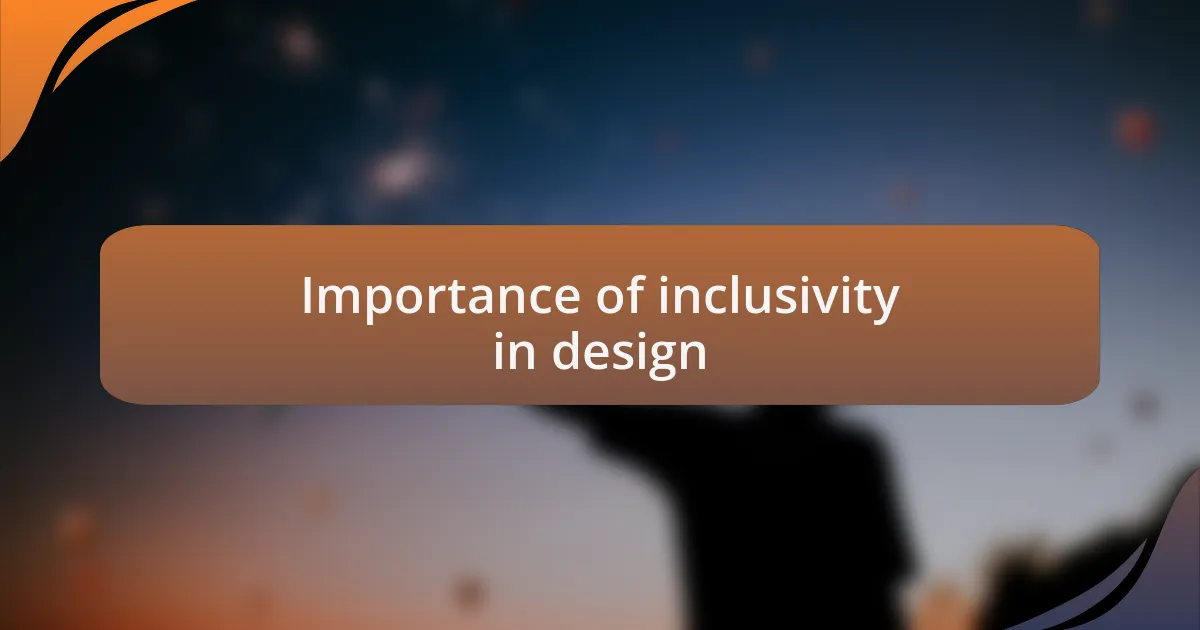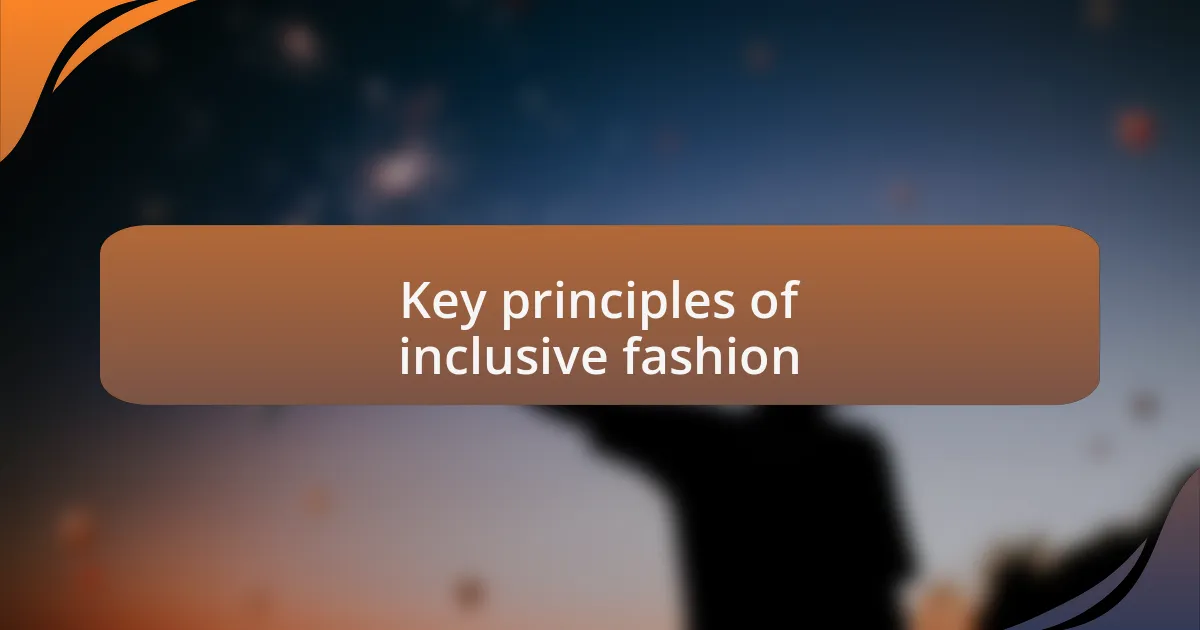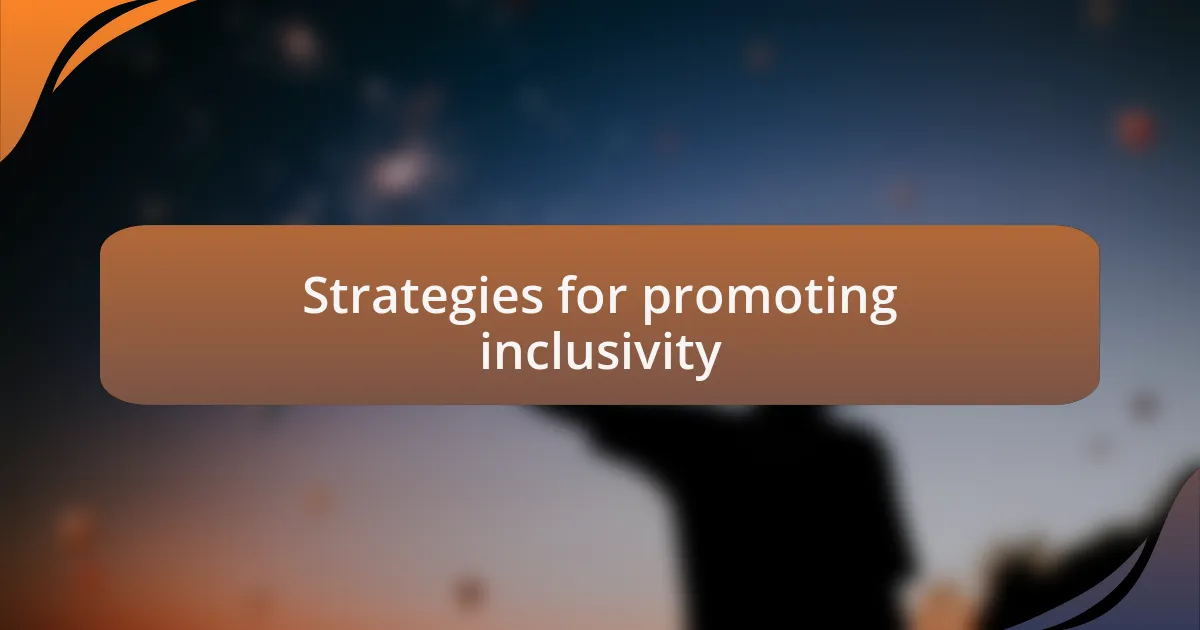Key takeaways:
- Inclusivity in fashion enhances representation and celebrates diversity, empowering individuals to express their identities through style.
- Designers play a critical role in promoting inclusivity, driving innovation by considering diverse needs and perspectives.
- Key principles of inclusive fashion include accessibility, representation, and versatility, challenging traditional norms and creating a richer fashion experience.
- Successful inclusive brands like Savage X Fenty and Universal Standard emphasize body positivity and community engagement, reshaping industry standards.

Understanding inclusivity in fashion
Inclusivity in fashion isn’t just a trend; it’s a fundamental shift in how we perceive beauty and identity. I remember attending a fashion show where models of all shapes, sizes, and backgrounds graced the runway. The energy was palpable, and it struck me how powerful representation can be—when we see ourselves in fashion, it validates our existence in the world.
Have you ever felt out of place while shopping? I have. Walking into a store and not seeing clothing that reflects who you are can be disheartening. Inclusivity means creating spaces where everyone feels welcomed and celebrated. It encourages designers to think beyond traditional sizing and aesthetics, acknowledging the diverse beauty found in every person.
When we talk about inclusivity, we must also consider accessibility. It’s not just about size and shape but also about affordability and availability. I often think about friends who have disabilities and the struggle they face finding stylish yet functional clothing. How can we truly celebrate fashion if it’s not achievable for everyone? This question brings us closer to a more inclusive future where every individual can express themselves freely through what they wear.

Importance of inclusivity in design
Designers have a unique role in shaping societal perceptions, and inclusivity in design is essential to that influence. I recall a moment at a local art exhibit where an artist showcased pieces that catered to individuals of all abilities. Witnessing the joy on people’s faces as they connected with the artwork highlighted how crucial it is for design to consider everyone. When design is inclusive, it not only fosters diverse participation but also sparks creativity by challenging conventional ideas.
Moreover, inclusivity drives innovation in design. For example, I once collaborated with a brand on a project aimed at creating eyewear that catered to various facial structures and sizes. The process was enlightening, revealing that when we step outside our own experiences and consider the needs of others, we unveil opportunities for new solutions and styles. Isn’t it exciting to think how inclusivity can lead to groundbreaking products that resonate with a wider audience?
Additionally, inclusivity enriches the cultural tapestry of design. Each unique perspective contributes to a more vibrant creative environment. I remember discussing this with a fellow designer who shared stories from her travels and how different cultures approach fashion. This dialogue made me realize that when we embrace diverse voices, we cultivate a richer, more dynamic experience for everyone involved. Can we really afford to ignore these varied narratives that have so much potential to inspire?

Key principles of inclusive fashion
The key principles of inclusive fashion revolve around accessibility, representation, and versatility. Recently, I attended a fashion show where models of all shapes, sizes, and abilities showcased designs that made a powerful statement. It struck me how each garment was not just an outfit but a celebration of individuality, proving that true fashion is about every body.
Another critical aspect is the importance of diverse representation in marketing and campaigns. I fondly recall working on a promotional shoot that featured individuals from various backgrounds, each person bringing their unique story to the table. It was rewarding to witness how this inclusion resonated with a broader audience, showing that inclusivity is not merely a trend but an essential practice in communicating with consumers.
Finally, versatility plays a crucial role in inclusive fashion. Adapting designs to serve various needs, like adjustable waistbands or adaptive clothing for individuals with disabilities, is something I deeply believe in. I once designed a dress that could transition from day to night with simple adjustments, allowing wearers to express themselves in multiple ways. Isn’t it empowering to create pieces that reflect the diverse lifestyles and preferences of everyone?

Examples of inclusive fashion brands
One brand that I admire for its commitment to inclusivity is Savage X Fenty. When I first watched their runway show, I was struck by how models of all sizes, shapes, and ethnicities walked with confidence, showcasing lingerie designed not just for traditional beauty norms but for every body. It reminded me of the powerful message that everyone deserves to feel sexy, worthy, and celebrated, regardless of societal standards.
Then there’s Aerie, known for its body-positive marketing campaigns and sizing range. A few years back, I found myself browsing their catalog and was pleasantly surprised to see models who looked like me, showcasing the latest styles. It felt refreshing and inclusive, challenging the industry’s long-standing norms about beauty and representation. I still remember the first item I purchased from them; wearing it felt like embracing my own story and celebrating my journey.
Another noteworthy mention is Universal Standard, a brand that truly prioritizes size inclusivity with a range up to size 40. I once attended a pop-up event, where I saw how the founders engaged with customers by not only selling clothes but also listening to their narratives. It was more than just a shopping experience; it was a community celebration, proving that fashion can be both inclusive and stylish, and that’s something I hold close to my heart.

My personal journey in fashion
My journey in fashion has been deeply personal and often intertwined with my evolving sense of self. I recall the first time I tried on a tailored blazer that fit perfectly; it was not just a piece of clothing but a revelation. It ignited a realization that fashion could empower me, transforming how I viewed my own identity in a space often dictated by narrow standards.
As I delved deeper into the world of style, I recognized an underlying passion for diversity and representation. I remember attending a local showcase where designers highlighted their work with models from various backgrounds and abilities. Witnessing this beautiful tapestry of humanity on the runway made me wonder, how could fashion tell all our stories? It was a turning point for me, inspiring my dedication to advocate for inclusivity in trends and narratives.
Throughout my journey, I have also been compelled to challenge my own biases and beliefs about beauty. There have been moments of doubt, especially when faced with the industry’s limited definitions. I vividly remember a conversation with a friend who felt discouraged by her experience shopping for clothes. It reminded me that inclusivity isn’t just a trend; it’s a necessary movement, ensuring that every individual feels seen, celebrated, and connected in their unique fashion journey.

Strategies for promoting inclusivity
To effectively promote inclusivity in fashion, we must focus on diverse representation within the industry. I think back to a recent fashion event where models of all shapes, sizes, and backgrounds graced the runway. The energy in the room was palpable, as each model’s uniqueness was celebrated. It made me question why this isn’t the standard everywhere. Seeing everyone recognized not only elevates the brand but also creates a richer narrative for consumers.
Another strategy that resonates with me is collaboration with marginalized communities. I was fortunate to work with a local artist who has a disability. Together, we co-created a limited-edition collection that showcased adaptive clothing. Because of this experience, I realized how empowering it is to listen and incorporate voices that have often been silenced in the design process. By doing so, we invite innovation and authenticity into fashion.
Lastly, I believe transparency about size and fit can significantly reduce the stigma around body diversity. I recall browsing a popular online retailer, only to be baffled by the inconsistent size charts. This left me and many others feeling disheartened. Wouldn’t it be more inviting if brands provided detailed fit information and showcased everyday people instead of just professional models? It’s all about fostering a sense of trust and belonging in an industry that too often feels exclusive.